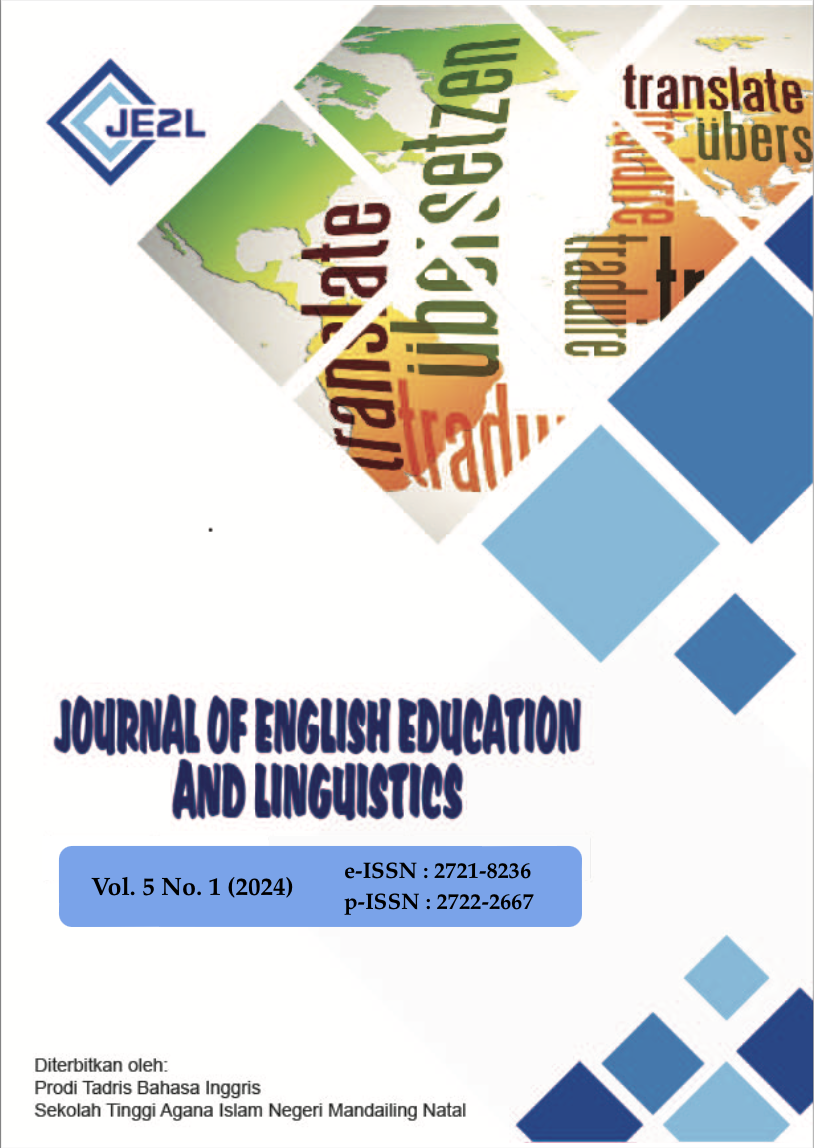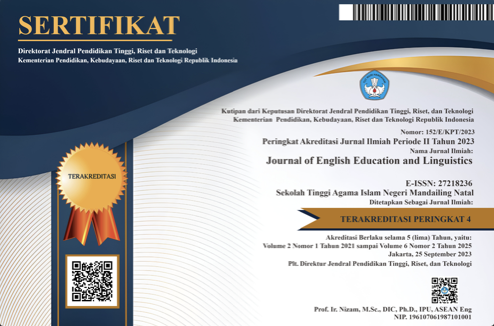STUDENTS’ PERSPECTIVES OF YOUTUBE USAGE IN DEVELOPING AUTONOMOUS LEARNING IN ELT CONTEXTS
DOI:
https://doi.org/10.56874/jeel.v5i1.1858Keywords:
Autonomous learning, English language skills, English language teaching, technology, YouTubeAbstract
YouTube is a well-known platform that everyone can use in every context, including the educational field. Despite the enormous benefit of YouTube usage in the learning context, only a little has been discussed about how YouTube can be used in developing students' autonomous skills. This current research aims to explore students' perceptions of the role of YouTube videos in developing students' autonomous learning and English language skills. This research was examined using a qualitative design and a type of data collection using a closed-ended questionnaire distributed to students in the form of a Google Form. The research subjects include 11 students of 5th-semester English education majors at State Islamic University Syarif Hidayatullah Jakarta who utilize YouTube to study English outside of class. Findings showed that YouTube is effective in developing autonomous learning skills. Furthermore, a major number of students specifically identified listening and vocabulary skills as areas where YouTube may help their autonomous learning activities.
References
Balbay, S., & Kilis, S. (2017). Students’ Perceptions of The Use of A YouTube Channel Specifically Designed for An Academic Speaking Skills Course. Eurasian Journal of Applied Linguistics (Vol. 3, Issue 2). www.ejal.eu
Buzzetto-More, N. A. (2014). Interdisciplinary Journal of E-Learning and Learning Objects An Examination of Undergraduate Student’s Perceptions and Predilections of the Use of YouTube in the Teaching and Learning Process. Journal of E-Learning and Learning Objects. http://www.ijello.org/Volume10/IJELLOv10p017-032Buzzetto0437.pdf
Dara Ilfa Rahila, C., & Hasyimsyah Batubara, M. (2023). The Influence of YouTube on Listening Skills. Journal of Linguistics, Literature and Language Teaching (JLLLT), 3(1), 1–7. https://jurnal-assalam.org/index.php/JLLLT
Deng, L., & Yuen, A. H. K. (2011). Towards a framework for educational affordances of blogs. Computers & Education, 56(2), 441–451. https://doi.org/10.1016/j.compedu.2010.09.005
Elliott, D. (2013). Teaching and Researching Autonomy (Second edition). ELT Journal, 67(2), 273–274. https://doi.org/10.1093/elt/cct001
Fadhilah, H., Putri, H., Wijayanto, A., & Supriyadi, S. (2020). Strengths and Weaknesses of Self-Regulated Learning through YouTube: Indonesian EFL Students’ Perceptions. ELS Journal on Interdisciplinary Studies on Humanities, 3. https://doi.org/10.34050/els
Harahab Putri, F. (2019). YouTube for Self-Regulated Language Learning: An EFL Perspective. English Education: Jurnal Tadris Bahasa Inggris, 12(2), 42. https://ejournal.radenintan.ac.id/index.php/ENGEDU
Jaffar, A. A. (2012). YouTube: An Emerging Tool in Anatomy Education. Anatomical Sciences Education, 5(3), 158–164. https://doi.org/10.1002/ase.1268
Kristiani, P. E., & Pradnyadewi, D. A. M. (2021). Effectiveness of YouTube as Learning Media in Improving Learners’ Speaking Skills. The Art of Teaching English as a Foreign Language, 2(1), 7–11. https://doi.org/10.36663/tatefl.v2i1.97
Kurniawan, I. (2019). Student’s Perception on The Use of Youtube As A Learning Media To Improve Their Speaking Skill. In International Seminar And Annual Meeting Bks-Ptn Wilayah Barat, 1(1).
Lai, C., & Gu, M. (2011). Self-Regulated Out-of-class Language Learning with Technology. Computer Assisted Language Learning, 24(4), 317–335. https://doi.org/10.1080/09588221.2011.568417
Nissak, K., Rahmati, N. A., & Hidayanti, I. (2023). EFL Student’s Perceptions of Learning Listening Through YouTube. Jurnal Penelitian, Pendidikan, Dan Pembelajaran, 18(14).
Nofrika, I. (2019). EFL Students’ Voices: The Role of YouTube in Developing English Competences. Journal of Foreign Language Teaching and Learning, 4(1), 56–73.
Novawan, A., Mila Alvarez-Tosalem, S., Wicaksono, J. A., & Setiarini, R. B. (2021). Students’ Experiences of Online English Language Learning by Using YouTube.
Purwanti, N. K. R., Suwastini, N. K. A., Adnyani, N. L. P. S., & Kultsum, U. (2022). Youtube videos for improving speaking skills: the benefits and challenges according to recent research in EFL context. Jurnal Pendidikan Teknologi Dan Kejuruan, 19(1), 66–75.
Rajendran, R., & Din, R. (2021). YouTube as A Resourceful Tool to Enhance Learner Autonomy in English Language Learning Among University Students. In Journal of Personalized Learning (Vol. 4, Issue 1).
Safitri, A. (2021). The Effectiveness of Using YouTube in Teaching English Listening to Elementary School Students. Prosiding Pekan Ilmiah Mahasisa UNIS, 1(1), 237–244.
Shariff, S. B. M., & Shah, P. M. (2019). Pupils Perception of Using YouTube and Autonomous Learning. Creative Education, 10(13), 3509–3520. https://doi.org/10.4236/ce.2019.1013270
Supendra, D., & Amilia, W. (2021). The Use of Youtube to Increase the Students’ Autonomous Learning in the Online Learning Situation. Advances in Social Science, Education and Humanities Research, 563. http://expandedramblings.com/index.php/youtube-
Wang, H. chun, & Chen, C. W. yu. (2020). Learning English from YouTubers: English L2 Learners’ Self-Regulated Language Learning on YouTube. Innovation in Language Learning and Teaching, 14(4), 333–346. https://doi.org/10.1080/17501229.2019.1607356
Watkins, J., & Wilkins, M. (2011). Using YouTube in the EFL Classroom. Language Education in Asia, 2(1), 113–119. https://doi.org/10.5746/LEiA/11/V2/I1/A09/Watkins_Wilkins
Downloads
Published
Issue
Section
License
All articles published in the Journal of English Education and Linguistics are licensed under a Creative Commons Attribution-ShareAlike 4.0 International (CC BY-SA) license. This means anyone is free to copy, transform, or redistribute articles for any lawful purpose in any medium, provided they give appropriate attribution to the original author(s) and Journal of English Education and Linguistics, link to the license, indicate if changes were made, and redistribute any derivative work under the same license.
Copyright on articles is retained by the respective author(s) without restrictions. A non-exclusive license is granted to the Journal of English Education and Linguistics to publish the article and identify itself as its original publisher, along with the commercial right to include the article in a hardcopy issue for sale to libraries and individuals.
Although the conditions of the Creative Commons Attribution-ShareAlike 4.0 International (CC BY-SA) license do not apply to authors (as the copyright holder of your article, you have no restrictions on your rights), by submitting to the Journal of English Education and Linguistics, authors recognize the rights of readers and must grant any third party the right to use their articles to the extent provided by the license.

This work is licensed under a Creative Commons Attribution-ShareAlike 4.0 International License.








